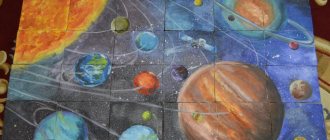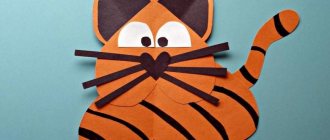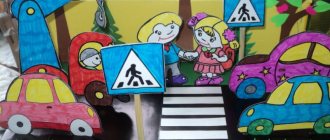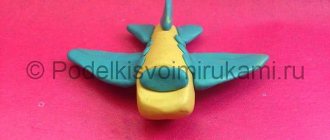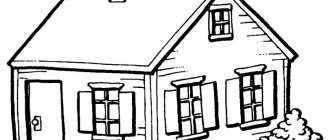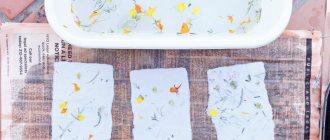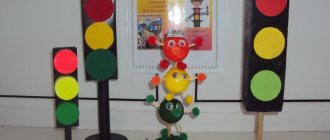didactic game “Who Lives Where”
Construct of joint educational activities
according to PM 02 Organization of various types of activities and communication of preschool children
specialty 44.02.01 Preschool education of the student group 33 “B” group
Date of:
DOO:
Kindergarten No. 73
Age group:
second youngest
Head of practice:
Methodist:
Educator:
Educational area:
cognitive development; artistic and aesthetic development, speech development
Form of organization:
group
Activities
: didactic game “Who lives where?”
Didactic task
: Teach children to group objects into pairs according to a given condition.
Game task
: play his favorite game with the little bear.
Game rules
: distribute the animals to their homes.
Game actions:
looking at pictures, saying words, matching animals.
Target:
developing children’s ability to correlate images of animals with their habitat, correctly naming the animal
Planned results:
Children show interest in joint play activities;
Children show interest in nature, respect for nature and animals;
Children are attentive, analyze and compare during play activities, and demonstrate the ability to distinguish colors;
Children recognize the image of the animal in the image;
Children have an idea of the appearance, lifestyle and dwellings of the inhabitants of nature.
| TASKS educational program | Tasks taking into account the individual characteristics of group students |
| Educational tasks : Cultivate interest in joint gaming activities. Develop an interest in animals. Developmental tasks: Develop attention and mental operations (analysis and comparison) during gaming activities. Enrich your vocabulary with the names of domestic and wild animals; To develop the ability to use generalizing words in speech. Training tasks: Expand children's understanding of the appearance of animals; Teach children to name animals, classify them into subgroups (wild and domestic). |
Principles of preschool education (FSES):
building educational activities based on the individual characteristics of each child, in which the child himself becomes active in choosing the content of his education, becomes the subject of education;
assistance and cooperation of children and adults, recognition of the child as a full participant (subject) of educational relations;
supporting children's initiative in various activities;
formation of cognitive interests and cognitive actions of the child in various types of activities;
age adequacy of preschool education (compliance of conditions, requirements, methods with age and developmental characteristics);
Who lives in the forest
This lesson is dedicated to forest representatives. In this case, the pictures should depict animals living in the forest.
During the lesson, the teacher tells what animals live there, shows what they look like, and in conclusion gives a small task.
Each participant gets a drawing depicting a forest animal. We need to tell him everything he knows about him. Thus, the studied material will be well consolidated.
Card No. 4
Card No. 5
For such an activity, you can think of a soundtrack with the voices of forest animals. It is advisable to place a large poster depicting a forest on the board. Using stickers, you can attach cards with animals to it. This will develop not only auditory, but also visual memory.
Who lives next to people
The presenter introduces participants to pets and tells them what benefits they bring to humans. It also shows where they live and how people care for them.
Card No. 5
Card No. 7
Card No. 7
The drawings are distributed to the participants, and they tell who is depicted there. Fix the material.
Summary of a lesson on speech development for children with special needs “Who lives where?”
Municipal preschool educational institution combined type kindergarten No. 390
SUMMARY of a lesson on speech development with children of senior preschool age “WHO LIVES WHERE?”
Authors-developers: teachers of MDOU No. 390 Varvarina Irina Aleksandrovna Malova Marina Aleksandrovna
Nizhny Novgorod 2010 Type of children's activity: speech development of children with special needs development. Age group: senior preschool age. Methods and techniques of work: Verbal - conversation, explanation, explanation, story, clarification, addition. Visual - illustrations depicting wild animals, their homes, traces; winter forest layout; animal toys. Games - psycho-gymnastics “Winter Forest”; finger gymnastics “Squirrel Gifts”. LESSON TOPIC: “WHO LIVES WHERE?” Objectives: * Consolidating knowledge about wild animals, getting to know their homes. * Expansion and activation of vocabulary on the topics “Wild Animals”, “Winter”. * Formation of practical skills in the correct use of relative adjectives, consolidation of the ability to coordinate nouns with an adjective. * Development of skills of coherent expression, cognitive abilities, imagination, creativity. * Formation of an ecological culture, nurturing a sense of beauty. Materials and equipment for the lesson: * Tape recorder, cassette with a recording of P. I. Tchaikovsky’s music “The Seasons”; * Items for the “winter forest”: artificial spruce trees, branches, cotton wool, snowflakes, white paper (road with hare tracks), a basket with nuts, cones, toys: hare, squirrel, wolf, fox; * Flannelographs; * Picture material (wild animals, their homes, two or three Christmas trees, bushes, sun, snowdrifts, clouds, snowflakes, etc.); * Bunny masks.
Lexical material:
Active vocabulary Passive vocabulary Nouns: Bear, fox, wolf, squirrel, hare, hedgehog, elk; muzzle, mouth, body, tail, wool, skin; den, lair, hole, hollow, honey, beehive; beast-beast, bunny-hares, bear-cubs; legs, paw, claws, fangs, teeth, horns, hooves, needles (hedgehog); nut, cone, mushroom; animals. Coward, cheat. Verbs: Jump, gallop, run, walk, gnaw, hide, howl, growl, roar, climb, escape, hide, prepare (for the winter), molt. To meander, wander, scour. Adjectives: Shaggy, brown, clumsy, club-footed, predatory, angry, hungry, gray, angry, prickly, white, oblique, cowardly, timid; red, fluffy, cunning, fast, dexterous (fox). Clumsy, nimble, nimble.
Preliminary work: Productive activities: • Construction (from paper) based on the fairy tale “Kolobok” • Application (collective) based on the fairy tale “Teremok” • Drawing “At the Zoo”. Didactic games: “When does this happen?”, “Hunter”, “Whose house is this?”, “Who eats what?”, “Birthday”, “Who is lost?”, “Guess who it is?”, “Who is in lives in a house? Games - dramatizations: B. Zakhoder “Hedgehog”, S. Marshak “Hedgehog and Fox”, “Wolf and Fox”, “Bear and Fox”, “Fox and Mouse”, G. Skrebitsky “Everyone in His Own Way”, S. Mikhalkov "Greedy Hare". Poems: Z. Aleksandrova “Bear”, “Wolves”, “Hedgehog”, “Fox Cubs”, “Squirrel”, G. Vieru “Hedgehog and Ram”, I. Tokmakova “Bear”, K. Chukovsky “Hedgehogs Laugh”, “ Thrifty squirrel" Stories: L.N. Tolstoy “Lambs and the Wolf”, V. Bianki “Bathing of the Cubs”, A.K. Tolstoy “Fox Patrikeevna”, E. Charushin “Wolf”, “Bear and Cubs”, N. Sladkov “Fox and Hedgehog”, “Fox and hare”, G. Snegirev “Bear cub”. Fairy tales: “Kids and the Wolf”, “Kolobok”, “Three Bears” (Arranged by L. Tolstoy), “Masha and the Bear” (Arranged by M. Bulatov), “Fox, Hare and Rooster”, “Wolf and Seven Little Kids” ", "A fox with a rolling pin" (Arranged by M. Bulatov), "Fox and a jug" (Arranged by K.D. Ushinsky), C. Perrault "Little Red Riding Hood". Outdoor games with speech accompaniment: “Fox”, “Hares and the Fox”, “Escape the Pit”, “Little Houses”, “Hare Hunting”. Collective retellings of fairy tales using children's drawings or flannelgraph.
Progress of the lesson. Introductory part. Speech therapist. Today guests came to our lesson. Guess who? Jumping through the trees. Yes, the nuts are click-click. Children: A squirrel came to us. (after each answer, the speech therapist puts a picture of an animal on the flannelgraph). Speech therapist. How did you guess? Children. The squirrel eats nuts. She is fast and jumps easily. Speech therapist. In summer he walks with a clubfoot, and in winter he sucks his paw. Children. Bear. Speech therapist. How do you understand the word “clubfoot”? (Step your heels apart, awkwardly, awkwardly). Red-haired, cunning, steals chickens. Children. Fox. Speech therapist. What does cunning mean? Children. Smart. She is deceiving everyone. The fox hides her intentions (desires). Speech therapist. The creeper crawls, the needles are carried on itself. Children. Hedgehog. Speech therapist. What else can you say about the hedgehog? Children. It has prickly needles. He eats apples. In winter it sleeps for a long time.
Speech therapist. Long ear, ball of fluff, jumps deftly, loves carrots. Children. Hare. Speech therapist. What else can you say about the hare? Children. He changes his fur coat; in winter it is white. The hare is afraid of everyone. Speech therapist. Who walks around angry and hungry in the cold winter? Children. Wolf. Speech therapist. Look at the pictures that appeared on the flannelgraph. Name our guests in one or two words. Children. Animals. Wild animals. Speech therapist. Why are these animals called wild? Children. They live in the forest and are afraid of humans. These are untamed animals. Report the topic of the lesson. Speech therapist. Now we will continue the conversation about wild animals and their homes. How do you understand the word “dwelling”? (“A dwelling is a place where animals live away from human habitation”) You know the names of some animal dwellings. But we’ll see what they look like in a fairytale forest. Main part. Conducting a psycho-gymnastic study. Music is playing. Speech therapist. Close your eyes and imagine everything I am going to tell you about. Winter is on the street. Everything around is white and white. The snow sparkles underfoot. We got on our skis and went into the forest. It's quiet in the forest. The branches of the trees became heavy with snow and sank down. The trees are like something out of a fairy tale: fluffy snowflakes cling to all the branches. Crown (the so-called upper part
tree) is all dazzling white, only the trunk darkens against the background of fluffy snow. As soon as the breeze blows, the snow begins to fall off the branches. And it's so beautiful. Now, children, let's open our eyes. I'll tell you a secret that a small corner of a fairytale forest is located next to us. Look and listen? Children. It's quiet here. There are green Christmas trees strewn with snowflakes. There are birds in the trees. A squirrel sits in a hollow. The music stops. Speech therapist. Where? Show it to me. What is the name of her house? Children. Her house is called a hollow. Speech therapist. A squirrel cannot hollow out a hole for itself. Where do you think it comes from? Children. Another squirrel lived there. A squirrel found a home in an old tree. Speech therapist. The squirrels settle in the hollow left by the woodpecker. They insulate it with moss, dry leaves and grass. (He opens the basket, overturns it, nuts and small pine cones roll out in the “snow.”) Oh! What have I done. Where do you think this comes from? Children. These are squirrel reserves for the winter. She collected it herself. Speech therapist. Take a nut or cone and place it on your palm. Consider them. Conducting finger exercises and exercises to prevent visual impairment. Speech therapist. Let's play with nuts (cones). Children squeeze nuts and cones into their fists (5-10 times), roll them between their palms (up and down, left and right), make circular movements on their palms, then extend their right hand, hold these objects with their thumb and forefinger and slowly move their hand to the right , to the left, make circular movements with their hand and carefully follow the movement of the object with their eyes, without turning their head. You did very well. Place the nuts and cones in a basket and leave them for the squirrel. Now look, what is this? (Puts out a picture). Children. This is a hole. We see the fox's tail. This is the fox's house.
Speech therapist. This is a fox hole, let's repeat the name of the fox's house. Children pronounce the sentence in chorus and individually. What is the name of the bear's home? Children. Den. Speech therapist. Let's fantasize and imagine how a bear builds a den for itself? Children. A large tree fell and the bear crawled under it. It's a big hole with branches on top. Speech therapist. I accept your answers and agree with you in many respects: the bear makes a den in a large hole, always in a dry place, under an uprooted tree and falls asleep there. Where do you think the bear is located in our “forest”? The children point to a large “snowdrift”. But we won’t disturb the bear; let him sleep in his den. Who else sleeps in winter? Children. Hedgehog. Speech therapist. What kind of home does a hedgehog have? Children. He sleeps in the leaves. Speech therapist. Hedgehogs sleep for six months. They crawl under a pile of leaves, grass, branches, and sometimes under the roots of old trees. Now look, whose tracks are these? (Puts out a picture). Children. These are traces of a fox and a hare. Speech therapist. That's right, now you and I will turn into bunnies and jump in the rabbit's tracks. I think they will lead us to the hare's house. Dynamic pause. Children put on hats with ears and jump in the rabbit's tracks. Speech therapist. Where do you think the hare is? Why is he not in his home?
Children. The hare ran away. He's afraid of everyone. They are hunting him. He doesn't have a home. Speech therapist. Hares do not build permanent homes for themselves. They are resting, sleeping under a bush. In winter they can hide in a snow hole. The holes and bushes are different every time. Let's get away from this bush. Maybe the hare got scared of us and that’s why it ran away. Children jump to another “tree” and take off their hats. What animal's home have we not named? Children. We did not name the wolf's home. Speech therapist. The wolf's home is called a lair - a small hole with a lot of grass and twigs in it. Listyev. From above it is covered with branches, old twigs, so the snow does not fall into the hole. The wolf in the den sleeps, hides, rests. What is the name of a wolf's home? Children answer in chorus and individually. Our journey has now ended. It's time to return to the group. What did you like about the forest? Children. A hollow in which a squirrel lives. How we turned into bunnies. Speech therapist. Children, go to the table, take the drawn homes of wild animals and attach the house of each animal on the flannelgraph. Now you need to answer my questions one by one in a complete sentence. Where does the fox live? Children. The fox lives in a hole. Speech therapist. So, whose hole is this? Children. This is a fox hole. Speech therapist. Where does the squirrel live? Children. The squirrel lives in a hollow. Speech therapist. Whose hollow? Children. This is a squirrel hollow.
Speech therapist. Where does the bear live? Children. The bear lives in a den. Speech therapist. Whose den is this? Children. This is a bear's den. Speech therapist. Where does the hare live? Children. The hare has no home, he lives under a bush. Speech therapist. Where does the hedgehog live? Children. The hedgehog hides for the winter in dry leaves and grass. Speech therapist. Guys, I propose to create a fairy forest on flannelgraph. Children take picture material (Christmas trees, snowflakes, etc.) and attach it. I really like it, how about you? Let's come up with a name for our picture. Children. In the forest. Fairy forest. Final part. Speech therapist. Do you think it’s good for animals to live in the forest? Children. Fine. They feel comfortable there. The forest feeds them. Speech therapist. How should people behave in the forest? Children. You cannot break anything in the forest or chase insects and animals. We must protect beauty. The forest must not be polluted. Speech therapist. You made me happy with your answers. You knew how to listen to your friends’ answers, you were friendly, so let’s give each other a smile when we say goodbye. And the squirrel has some gifts for you (the children are given a basket with nuts and mushrooms).
DEAR PARENTS! We work on the topic: “WILD ANIMALS”. Dictionary on the topic: Subjects: Animals, bear, fox, wolf, hare, squirrel, hedgehog. Badger, raccoon, elk, deer, marten, otter, cubs, den, hole, hollow, thickets, watering hole, horns, hooves, fangs, wool, mane, fur, needles, skin. Actions: Prey, jump, prowl, hide, hunt, growl, howl, teach, guard, clang, hide, squeak, sneak. Signs: Shaggy, shaggy, fluffy, strong, cunning, prickly, fast, dexterous, brown, toothy, clumsy, club-footed, flexible, clumsy, cautious, predatory. LEXICAL-GRAMMAR GAMES AND EXERCISES: 1. “Pick up a sign”: bear - huge, strong, clumsy, club-footed, brown...; fox, wolf, hare, hedgehog, elk; 2. “Pick up actions”: a bear - walks, waddles, sleeps in a den, growls, roars, feasts on honey, sucks a paw...; 3. “Choose related words”: bear - she-bear, little bear, bear cub, bear, bear cub... 4. “Generate signs from objects”: bear - bearish, bearish, bearish, bearish;
5. “Name the cubs”: bear - bear cub, cubs; 6. “Call it affectionately”: bear - little bear, little bear; 7. “Match objects to the signs”: bear - tail, eye, nose; bear - paw, skin, wool, den; bear - ear, home, rumbling, 8. “Say otherwise” (synonyms): big bear - huge, huge, mighty, huge, large, hefty... 9. Repeat (learn) riddles about animals with the children: The tail is fluffy, He is in He sleeps in a den in winter, golden fur, under a huge pine tree, lives in the forest, and when spring comes, he steals chickens from the village. Wakes up from sleep. (fox) (bear) Not a tailor, but has been walking around with needles all his life. (Hedgehog). White in winter, gray in summer. (Hare). Who walks around angry and hungry in the cold winter? (Wolf). Jumping along the branches, But not a bird, Red-haired, But not a fox. (Squirrel). 10. “Draw the animal in an unconventional way” (with a loop, a stroke, in cells).
11. “Describe any animal according to plan”: -name; -where he lives; - appearance; - habits; -what does it eat; - how to obtain food; -how the cubs defend themselves; 12. “Who lives where?”: the bear is in a den;... 13. “Who spends the winter?”: The bear sleeps in a den, the wolf prowls the forests,... 14. Read to the children: Stories by E. Charushin “Hare”, “Squirrel” ", "Wolf"; Russian folk tales “Cat, Fox and Rooster”, “Fox and Crane”, “Tails”. 15. Draw (glue pictures) of wild animals into the album.
LITERATURE 1. Akishina A. A. Gestures and facial expressions in Russian speech.
Linguistic and regional dictionary. - M., 1991 2. Bogat V., Nyukalov V. Develop creative thinking (TRIZ in kindergarten) Preschool education.- 1994.-N1.-P. 17-19 3. Bogat V. Fairytale problems in TRIZ classes. Preschool education.-1995-N10.-S. 30-32. 4. Vygotsky L. S. Imagination and creativity in childhood. - St. Petersburg, 1997 5. Vygotsky L. S. Psychology of art. - Mn.: modern word, 1998. 6. Zinkevich-Evstigneeva T. D. Workshop on fairy tale therapy. - St. Petersburg, 2000. 7. Zinkevich-Evstigneeva T. D., Grabenko T. M. Workshop on creative therapy. - St. Petersburg: Rech, TC Sfera, 2001. 8. Kudryavtsev V. Child’s imagination: nature and development: Art. 1 /V.T. Kudryavtsev Psychological Journal.-2001.-T. 22.-N5.-P.57-68. 9. Kudryavtsev V., Sinelnikov V. Child - preschooler: a new approach to diagnosing creative abilities║ Preschool education. - 1995. - N9. - P. 52-59. Full text of the material Summary of the lesson on speech development of children with special needs “Who lives where?”
see the downloadable file . The page contains a fragment.
| Author: Varvarina Irina Aleksandrovna → aa7092 12/06/2010 8 29446 864 | Comment |
Thank you for your mark. If you want your name to be known to the author, log in to the site as a user and click Thank you again. Your name will appear on this page.
Login | Registration
Have an opinion? Leave a comment
What to do with a preschooler at home and in kindergarten
In kindergartens, didactic games are widely popular because children love to play and learn the material well in this environment.
While at home, the baby can also develop with the help of didactic games for the younger group. “Who lives where” is the simplest option. Doing a familiar pastime with your parents can show how much you have learned. Parents, in turn, consolidate knowledge and teach new species of animals.
There are plenty of options for home games. You can make them with your own hands, involving your baby in the creative process. Cutting out printed pictures is not difficult, the main thing is parental control. When the material is ready, mom can try herself in the role of a teacher, talking about the inhabitants of a particular territory. Then propose that all representatives be sent to their homes.
If errors are made, corrections must be made. After a while you can play again.
Who swims in the sea
In this lesson, the presenter needs to tell that in addition to land inhabitants, there are aquatic inhabitants. If equipment allows, show a short video about the underwater world. In this case, the pictures should be with sea inhabitants, and the poster with the seabed. In order to develop thinking, drawings with aquatic inhabitants can be mixed with images of land inhabitants. To make it more interesting, allow participants to remove the pictures from the box with their eyes closed.
Next, the presenter asks everyone a question: “Does your animal swim in the sea? Why do you say that?". To which the participant must tell who he came across and what distinctive features told him that he was a marine resident.
During the lesson, the teacher gives time to formulate the story and helps with leading questions.



